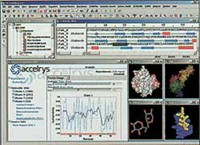Advertisement
Grab your lab coat. Let's get started
Welcome!
Welcome!
Create an account below to get 6 C&EN articles per month, receive newsletters and more - all free.
It seems this is your first time logging in online. Please enter the following information to continue.
As an ACS member you automatically get access to this site. All we need is few more details to create your reading experience.
Not you? Sign in with a different account.
Not you? Sign in with a different account.
ERROR 1
ERROR 1
ERROR 2
ERROR 2
ERROR 2
ERROR 2
ERROR 2
Password and Confirm password must match.
If you have an ACS member number, please enter it here so we can link this account to your membership. (optional)
ERROR 2
ACS values your privacy. By submitting your information, you are gaining access to C&EN and subscribing to our weekly newsletter. We use the information you provide to make your reading experience better, and we will never sell your data to third party members.
Physical Chemistry
Digital Briefs
New Software and Websites for the Chemical Enterprise
by Stephen M. Trzaska
May 7, 2007
| A version of this story appeared in
Volume 85, Issue 19
Software
(1) Sirius is a molecular visualization and discovery application that provides academic researchers and teachers with an advanced set of features, such as high-quality graphics, structure building, protein-structure alignment and editing, and integrated access to online databases. Sirius can be used as a stand-alone application and a graphics component for database-driven projects. It is well-suited for both protein-oriented work and for manipulation of small druglike molecules. The application supports all major structure and sequence formats and is available for Windows, MacOS X, and Linux. Sirius is available for free to academic and nonprofit organizations. San Diego Supercomputer Center, sirius.sdsc.edu
REACH 123 is a suite of software tools developed to help chemical companies comply with the European Union's REACH (Registration, Evaluation & Authorization of Chemicals) legislation, which requires affected manufacturers to gather and report comprehensive data of all chemicals manufactured in or imported to the EU. The software allows manufacturers to capture critical data, make decisions by analyzing these data, and send the data to the European Chemical Agency's database, IUCLID 5. Manufacturers will be able to seamlessly cross-reference their products with this established database to assess which chemicals will be impacted by REACH. The Wercs, www.thewercs.com
(2) ADMEWORKS ModelBuilder 3.0 is a tool for creating mathematical models that can later be used for predicting various chemical and biological properties of compounds. The models are based on values of physicochemical, topological, geometrical, and electronic properties derived from the molecular structure. The software employs a wide range of statistical methods and allows the creation of quantitative structure-activity relationships from more than 300 descriptors calculated using predefined generators. Interactive graphs can be used for presenting property distribution, predicted versus actual activity, and clustering of samples and properties. Free evaluation licenses are available. ADMEWORKS runs on Windows and Windows XP. Fujitsu, www.allosterix.com
DATABASES
KnowItAll U is a spectroscopy reference database and software product for academic research and teaching. The product represents a combination of reference data, tools, and technologies. KnowItAll U includes a collection of spectroscopy, cheminformatics, and chemometrics software tools and over 1.2 million IR, NIR, UV-Vis, NMR, Raman, and mass spectra data. KnowItAll U also features a Web-enabled browser client that allows access to the database collection via Windows, Macintosh, or Linux. Bio-Rad Laboratories, www.bio-rad.com
ONLINE
Organic Chemistry Flashware is a collection of interactive Web-based multimedia courseware designed as a study aid for students and a teaching aid for instructors. This collection has been produced to enhance the traditional lecture experience and is optimized for both the individual computer user and classroom projection. The courseware covers many aspects of organic chemistry, such as arrow-pushing notation to depict electron flow, step-by-step reaction mechanisms in pseudo-3D rendering, and orbital interactions. Organic Chemistry Flashware animations are now available and can be purchased individually or as an institutional subscription; they can be accessed from any Flash-enabled computer connected to the Internet. Thomson Nelson, flashchem.nelson.com
(3) "Introduction to HPLC Detectors, Data & Method Development" is an e-Learning program on the fundamentals of high performance liquid chromatography. The two-hour module defines and explains basic HPLC concepts through interactive animations, simulations, hot words, and other special features. The program describes the functions of output-producing and handling components, including UV-Vis and other detectors, as well as integration and data-processing systems. Method development and factors to be considered in qualitative and quantitative analysis are introduced and discussed. The tutorial features narration, an assessment quiz, a glossary, and bibliography. The tutorial is available online and on CD, which has a customization capability whereby instructors can add their own content to the program. Academy Savant, www.academysavant.com
Stephen M. Trzaska writes Digital Briefs. Information about new or revised electronic products can be sent to d-briefs@acs.org.









Join the conversation
Contact the reporter
Submit a Letter to the Editor for publication
Engage with us on Twitter